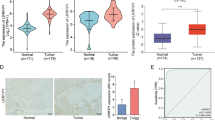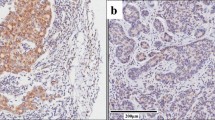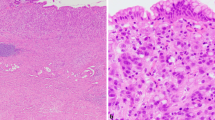Abstract
Recent studies have revealed that Musashi-1 and Lgr5 (leucine-rich-repeat-containing G-protein-coupled receptor 5) were putative stem cell genes. The epidermal growth factor receptor (EGFR) has also been extensively studied; it was known as an oncogenic driver in cancers. Overexpressions of Musashi-1, EGFR, and Lgr5 have been reported in some tumor tissues and cell lines. In this study, we used immunohistochemical analysis to investigate the expression pattern of Musashi-1, Lgr5, and pEGFR in 38 small intestinal adenocarcinomas (SIAs) resection specimens, 20 matched normal specimens and tried to analyze the correlations among them. The positive rate of Musashi-1, Lgr5, and pEGFR in SIAs, respectively, was 71 % (27/38), 55 % (21/38), and 45 % (17/38). Compared with the adjacent normal small intestinal mucosa, Musashi-1, Lgr5, and pEGFR protein were overexpressed in SIAs (P< 0.05). Furthermore, Musashi-1 and Lgr5 expressions were significantly correlated with the depth of wall invasion (P = 0.0011, P = 0.0017, respectively). Musashi-1 expression was closely correlated with Lgr5 (P = 0.015, r = 0.392). However, pEGFR expression was not associated with age, gender, tumor size, differentiation, depth of invasion, lymphatic metastasis, TNM stage, and pEGFR expression was not correlated with Musashi-1 or Lgr5 (P > 0.05, r = 0.064; P > 0.05, r = 0.307, respectively). Thus, we suggest that Musashi-1, Lgr5, and pEGFR are overexpressed in human SIAs and may play roles in human SIA carcinogenesis and progression.




Similar content being viewed by others
References
Siegel R, Naishadham D, Jemal A. Cancer statistics, 2012. CA Cancer J Clin. 2012;62:10–29.
Howe JR, Karnell LH, Menck HR, et al. The American college of surgeons commission on cancer and the American cancer society. Adenocarcinoma of the small bowel: review of the national cancer data base, 1985–1995. Cancer. 1999;86:2693–706.
Lu Y, Frobom R, Lagergren J. Incidence patterns of small bowel cancer in a population-based study in Sweden: increase in duodenal adenocarcinoma. Cancer Epidemiol. 2012;36:e158–63.
Dabaja BS, Suki D, Pro B, et al. Adenocarcinoma of the small bowel: presentation, prognostic factors, and outcome of 217 patients. Cancer. 2004;101:518–26.
Czaykowski P, Hui D. Chemotherapy in small bowel adenocarcinoma: 10-year experience of the British Columbia cancer agency. Clin Oncol (R Coll Radiol). 2007;19:143–9.
Koo DH, Yun SC, Hong YS, et al. Systemic chemo-therapy for treatment of advanced small bowel adenocarcinoma with prognostic factor analysis: retrospective study. BMC Cancer. 2011;11:205.
Jigyasu D, Bedikian AY, Stroehlein JR. Chemotherapy for primary adenocarcinoma of the small bowel. Cancer. 1984;53:23–5.
Bobryshev YV, Freeman AK, Botelho NK, et al. Expression of the putative stem cell marker Musashi-1 in Barrett’s esophagus and esophageal adenocarcinoma. Dis Esophagus. 2010;23:580–9.
Kuroda J, Yoshida M, Kitajima M, et al. Utility of preoperative chemoradiotherapy for advanced esophageal carcinoma. J Gastroenterol Hepatol. 2012;27 Suppl 3:88–94.
Siebzehnrubl FA, Jeske I, Muller D, et al. Spontaneous in vitro transformation of adult neural precursors into stem-like cancer cells. Brain Pathol. 2009;19:399–408.
McDonald T, Wang R, Bailey W, et al. Identification and cloning of an orphan G protein-coupled receptor of the glycoprotein hormone receptor subfamily. Biochem Biophys Res Commun. 1998;247:266–70.
Barker N, Clevers H. Leucine-rich repeat-containing G-protein-coupled receptors as markers of adult stem cells. Gastroenterology. 2010;138:1681–96.
Barker N, van Es JH, Kuipers J, et al. Identification of stem cells in small intestine and colon by marker gene Lgr5. Nature. 2007;449:1003–7.
Rezza A, Skah S, Roche C, et al. The overexpression of the putative gut stem cell marker Musashi-1 induces tumorigenesis through Wnt and Notch activation. J Cell Sci. 2010;123:3256–65.
Walker F, Zhang HH, Odorizzi A, et al. LGR5 is a negative regulator of tumourigenicity, antagonizes Wnt signalling and regulates cell adhesion in colorectal cancer cell lines. PLoS ONE. 2011;6:e22733.
Potten CS, Booth C, Tudor GL, et al. Identification of a putative intestinal stem cell and early lineage marker, Musashi-1. Differentiation. 2003;71:28–41.
Montgomery RK, Breault DT. Small intestinal stem cell markers. J Anat. 2008;213:52–8.
Nishimura S, Wakabayashi N, Toyoda K, et al. Expression of Musashi-1 in human normal colon crypt cells: a possible stem cell marker of human colon epithelium. Dig Dis Sci. 2003;48:1523–9.
Hirsch D, Barker N, McNeil N, et al. LGR5 positivity defines stem-like cells in colorectal cancer. Carcinogenesis. 2014;35:849–58.
Schulenburg A, Cech P, Herbacek I, et al. CD44-positive colorectal adenoma cells express the potential stem cell markers Musashi antigen (msi1) and ephrin B2 receptor (EphB2). J Pathol. 2007;213:152–60.
Fan LF, Dong WG, Jiang CQ, et al. Expression of putative stem cell genes musashi-1, and β1-integrin in human colorectal adenomas and adenocarcinoma. Int J Color Dis. 2010;25:17–23.
Uchida H, Yamazaki K, Fukuma M, et al. Overexpression of leucine-rich repeat-containing G protein-coupled receptor 5 in colorectal cancer. Cancer Sci. 2010;101:1731–7.
Toda M, Iizuka Y, Yu W, et al. Expression of the neural RNA-binding protein Musashi1 in human gliomas. Glia. 2001;34:1–7.
Shu HJ, Saito T, Watanabe H, et al. Expression of the Musashi1 gene encoding the RNA-binding protein in human hepatoma cell lines. Biochem Biophys Res Commun. 2002;293:150–4.
Ye F, Zhou C, Cheng Q, et al. Stem-cell-abundant proteins Nanog, Nucleostemin and Musashi1 are highly expressed in malignant cervical epithelial cells. BMC Cancer. 2008;8:108.
Yamanoi K, Fukuma M, Uchida H, et al. Overexpression of leucine-rich repeat-containing G protein-coupled receptor 5 in gastric cancer. Pathol Int. 2013;63:13–9.
Becker L, Huang Q, Mashimo Q. Lgr5, an intestinal stem cell marker, is abnormally expressed in Barrett’s esophagus and esophageal adenocarcinoma. Dis Esophagus. 2010;23:168–74.
Wu XS, Xi HQ, Chen L. Lgr5 is a potential marker of colorectal carcinoma stem cells that correlates with patient survival. World J Surg Oncol. 2012;10:244.
Todaro M, Francipane MG, Medema JP, Stassi G. Colon cancer stem cells: promise of targeted therapy. Gastroenterology. 2010;138:2151–62.
Al-Hajj M. Cancer stem cells and oncology therapeutics. Curr Opin Oncol. 2007;19:61–4.
Normanno N, De Luca A, Bianco C, et al. Epidermal growth factor receptor (EGFR) signaling in cancer. Gene. 2006;366:2–16.
Lurje G, Lenz HJ. EGFR signaling and drug discovery. Oncol-Basel. 2009;77:400–10.
Bianco R, Gelardi T, Damiano V, Ciardiello F, Tortora G. Rational bases for the development of EGFR inhibitors for cancer treatment. Int J Biochem Cell Biol. 2007;39:1416–31.
Sebastian S, Settleman J, Reshkin SJ, et al. The complexity of targeting EGFR signalling in cancer: from expression to turnover. Biochim Biophys Acta. 2006;1766:120–39.
Zhang H, Berezov A, Wang Q, et al. ErbB receptors: from oncogenes to targeted cancer therapies. J Clin Invest. 2007;117:2051–8.
Arteaga CL. ErbB-targeted therapeutic approaches in human cancer. Exp Cell Res. 2003;284:122–30.
Li S, Li Q. Cancer stem cells and tumor metastasis (Review). Int J Oncol. 2014;44:1806–12.
O’Brien CA, Pollett A, Gallinger S, et al. A human colon cancer cell capable of initiating tumour growth in immunodeficient mice. Nature. 2007;445:106–10.
Ricci-Vitiani L, Lombardi DG, Pilozzi E, et al. Identification and expansion of human colon-cancer-initiating cells. Nature. 2007;445:111–5.
Levin TG, Powell AE, Davies PS, et al. Characterization of the intestinal cancer stem cell marker CD166 in the human and mouse gastrointestinal tract. Gastroenterology. 2010;139:2072–82.
Chu P, Clanton DJ, Snipas TS, et al. Characterization of a subpopulation of colon cancer cells with stem cell-like properties. Int J Cancer. 2009;124:1312–21.
Carpentino JE, Hynes MJ, Appelman HD, et al. Aldehyde dehydrogenase expressing colon stem cells contribute to tumorigenesis in the transition from colitis to cancer. Cancer Res. 2009;69:8208–15.
Becker L, Huang Q, Mashimo H. Immunostaining of Lgr5, an intestinal stem cell marker, in normal and premalignant human gastrointestinal tissue. Sci World J. 2008;8:1168–76.
Garcia MI, Ghiani M, Lefort A, et al. LGR5 deficiency deregulates Wnt signaling and leads to precocious Paneth cell differentiation in the fetal intestine. Dev Biol. 2009;331:58–67.
Sureban SM, May R, George RJ, et al. Knockdown of RNA binding protein Musashi-1 leads to tumor regression in vivo. Gastroenterology. 2008;134:1448–58.
Morita H, Mazerbourg S, Bouley DM, et al. Neonatal lethality of LGR5 null mice is associated with ankyloglossia and gastrointestinal distension. Mol Cell Biol. 2004;24:9736–43.
Aguirre A, Rubio ME, Gallo V. Notch and EGFR pathway interaction regulates neural stem cell number and self-renewal. Nature. 2010;467:323–7.
Liu X, Qin J, Luo Q, et al. Cross-talk between EGF and BMP9 signalling pathways regulates the osteogenic differentiation of mesenchymal stem cells. J Cell Mol Med. 2013;17:1160–72.
Perez A, Neskey DM, Wen J, et al. CD44 interacts with EGFR and promotes head and neck squamous cell carcinoma initiation and progression. Oral Oncol. 2013;49:306–13.
Feng Y, Dai X, Li X, et al. EGF signalling pathway regulates colon cancer stem cell proliferation and apoptosis. Cell Prolif. 2012;45:413–9.
Conflicts of interest
None
Author information
Authors and Affiliations
Corresponding author
Rights and permissions
About this article
Cite this article
Wang, Y., Jiang, CQ. & Fan, LF. Correlation of Musashi-1, Lgr5, and pEGFR expressions in human small intestinal adenocarcinomas. Tumor Biol. 36, 6075–6082 (2015). https://doi.org/10.1007/s13277-015-3288-3
Received:
Accepted:
Published:
Issue Date:
DOI: https://doi.org/10.1007/s13277-015-3288-3




